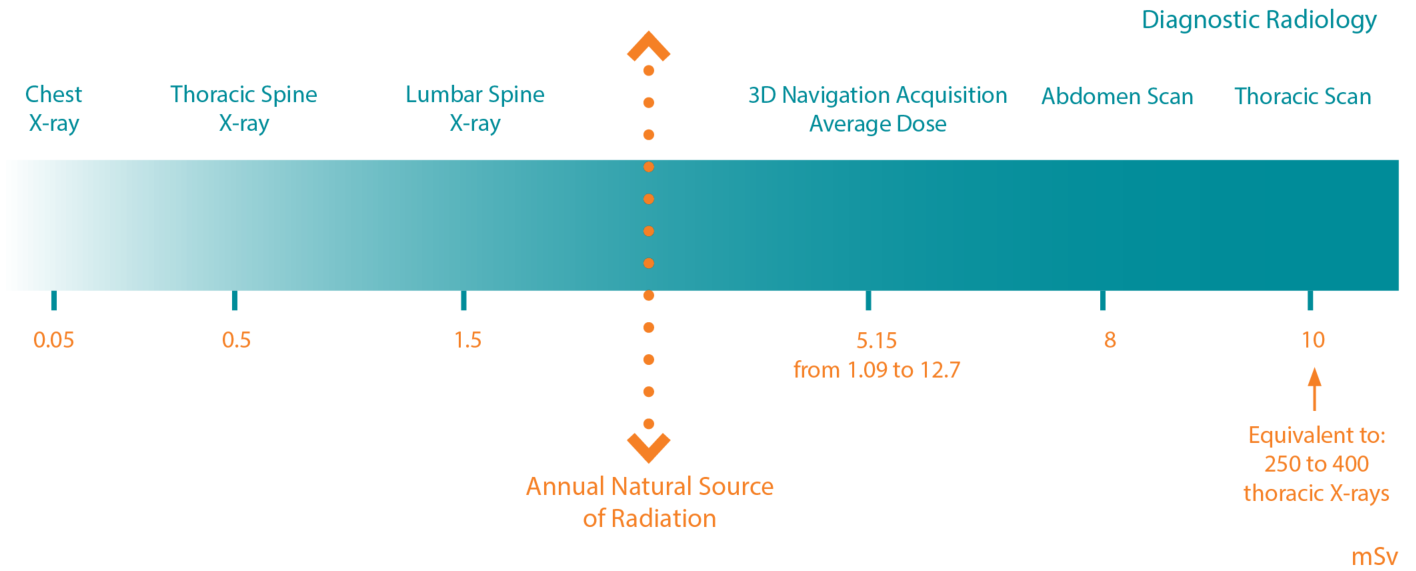The excessive use of fluoroscopy during Spine procedures exposes all operating room personnel at risk of dangerous radiation exposure.
Radiation exposure in spine surgery is excessive, protection is underutilized, and the long-term biological effects can be deadly. Fortunately, there is a growing concern among influential spine surgeons who are calling for the reduction of radiation vulnerability in the OR.
- Surgeons are highly exposed especially in MIS surgeries1 and scoliosis surgeries2.
- The annual limit dose to the eye of 20 mSv/year3,4 can be exceeded after:
– 220 open TLIF with 3.4 levels per case on average5,
– 112 MIS TLIF with one level per case6.

- Short-term to long-term consequences due to repetitive fluoroscopic procedures are:
– Back pain due to heavy protections7,
– Lens opacities8-10,
– Cancer (breast, neck, brain)11-13.
- Other limitations are observed:
– Protective equipment is low or insufficient especially at the eyes and neck14,
– Lead aprons are subject to internal wear and their protection can be weakened without visible changes15-17,
– Operator’s legs, arms and head are usually not fully protected.

CT scans for diagnosis and navigational assistance during spine surgery may expose a young patient to excessive radiation

Multiple CT scans increase incidence of cancer in children
Studies show that individuals who have had multiple CT scans before the age of 15 were found to have an increased risk of developing leukemia, brain tumors18, and other cancers19 in the decade following their first scan.
Intraoperative CT-based navigation will generate approximately one iatrogenic malignancy for every 1,000 patients treated for AIS20.
Girls are at higher risk of cancer development
Literature shows cancer risk is high for girls with 1 case projected to result from every 270 to 800 spine scans, depending on age21.
Radiation doses are high for adolescent trauma patients with spinal injuries
Imaging studies of adolescents with spinal injuries received a median cumulative effective dose of 18.89 mSv (range 0–86.87 mSv), equaling to that of adult trauma patients and nearly 3 times that of pediatric trauma patients22.
Surgery to correct scoliosis necessitates higher amounts of radiation
The intraoperative radiation exposure for placement and confirmation of posterior instrumentation in patients with adolescent idiopathic scoliosis (AIS) with an average of 11 levels fused ranges from 8 mSv for navigation to 16 mSv for navigation and confirmation23.
Patients receive 3 times higher amounts of radiation with CT-based navigation than with fluoroscopy.
DSG And Radiation Reduction
The use of PediGuard devices can significantly reduce the radiation exposure to the patient, the surgeon and the OR team. A randomized clinical trial24 assessed the accuracy and time for pedicle screw placement with the DSG Technology and the Free-Hand technique for posterior scoliosis surgery.
- There were totally 3 times less pedicle perforations in the DSG group than in the Free-Hand group;
- The average screw insertion time was decreased by 15% in the DSG group.
73%
Reduction of X-Ray time in MIS25.
30%
Reduction of X-Ray shots in open24,26.
51%
Reduction of thyroid radiation exposure to the surgeon25.
41%
Reduction of X-Ray shots in Anterior Scoliosis Correction27.
PediGuard family of products complies with the recommendations of the International Commission for Radiation Protection (ICRP) and the ALARA principle As Low as Reasonably Achievable28
References
1 – Bindal RK et al. J Neurosurg Spine. 2008 Dec;9(6):570-3
2 – Ul Haque M et al. Spine. 2006;31:2516–2520.
3 – International Commission on Radiological Protection. ICRP ref 4825-3093-1464. Statement on Tissue Reactions. Approved by the Commission on April 21, 2011
4 – Official Journal of the European Union. COUNCIL DIRECTIVE 2013/59/EURATOM of 5 December 2013. laying down basic safety standards for protection against the dangers arising from exposure to ionising radiation, and repealing Directives 89/618/Euratom, 90/641/Euratom, 96/29/Euratom, 97/43/Euratom and 2003/122/Euratom
5 – Villard J et al. Spine (Phila Pa 1976). 2014 Jun 1;39(13):1004-9.
6 – Grelat M et al. [Article in French]. Neurochirurgie. 2015 Aug;61(4):255-9. Epub 2015 Jun 10.
7 – Orme NM. Occupational health hazards of working in the interventional laboratory: a multisite case control study of physicians and allied staff. J Am Coll Cardiol. 2015 Mar 3;65(8):820-6. doi: 10.1016/j.jacc.2014.11.056.
8 – Mrena S. Scand J Work Environ Health 2011;37(3):237-243
9 – Vano E. J Vasc Interv Radiol. 2013 Feb;24(2):197-204 Epub 2013 Jan 28.
10 – Milacic S. Med Lav. 2009 May-Jun;100(3):178-86.
11 – Chou LB. Cancer Prevalence among a Cross-sectional Survey of Female Orthopedic, Urology, and Plastic Surgeons in the United States. Womens Health Issues. 2015 Sep-Oct;25(5):476-81. doi: 10.1016/j.whi.2015.05.005. Epub 2015 Aug 8.
12 – Roguin A. Brain and neck tumors among physicians performing interventional procedures. Am J Cardiol. 2013 May 1;111(9):1368-72. doi: 10.1016/j.amjcard.2012.12.060. Epub 2013 Feb 16.
13 – Luan FJ et al. European Spine Journal (2020) 29:3123–3134
14 – Wagner T.A et al. SRS meeting 2014
15 – Lambert K, McKeon T. Inspection of lead aprons: criteria for rejection. Health Phys. 2001 May;80(5 Suppl):S67-9.
16 – Ryu J.S et al. The Survey about the Degree of Damage of Radiation-Protective Shields in Operation Room. PMCID: PMC3629340. Korean J Pain. 2013 Apr; 26(2): 142–147.Published online 2013 Apr 3. doi: 10.3344/kjp.2013.26.2.142
17 – Matsuda M, Suzuki T. Evaluation of lead aprons and their maintenance and management at our hospital. J Anesth. 2016 Jun;30(3):518-21. doi: 10.1007/s00540-016-2140-2. Epub 2016 Feb 3.
18 – Pearce MS et al. Lancet. 2012 Aug 4;380(9840):499-505. doi: 10.1016/S0140-6736(12)60815-0. Epub 2012 Jun 7.
19 – Mathews JD et al. Cancer risk in 680 000 people exposed to computed tomography scans in childhood or adolescence: data linkage study of 11 million Australians. British Medical Journal 2013 May 21; 346:f2360
20 – Striano B et al. Intraoperative navigation increases the projected lifetime cancer risk in patients undergoing surgery for adolescent idiopathic scoliosis. The Spine Journal 2024 Jan 16 – https://doi.org/10.1016/j.spinee.2024.01.007
21 – Miglioretti DL et al. The use of computed tomography in pediatrics and the associated radiation exposure and estimated cancer risk. JAMA Pediatr. 2013 Aug 1;167(8):700-7. doi: 10.1001/jamapediatrics.2013.311.
22 – Lemburg SP et al. Cumulative effective dose associated with radiography and CT of adolescents with spinal injuries. AJR Am J Roentgenol. 2010 Dec;195(6):1411-7. doi: 10.2214/AJR.10.4616.
23 – O’Donnell C et al. Comparative radiation exposure using standard fluoroscopy versus cone-beam computed tomography for posterior instrumented fusion in adolescent idiopathic scoliosis. Spine (Phila Pa 1976). 2014 Jun 15;39(14):E850-5.
24 – Bai YS et al. Comparison of the Pedicle Screws Placement Between Electronic Conductivity Device and Normal Pedicle Finder in Posterior Surgery of Scoliosis. J Spinal Disord Tech. 2013 Aug;26(6):316-20.
25 – Lubansu A et al. Prospective Evaluation of a Free-Hand Electrical Conductivity Measuring Device to Reduce Radiation Exposure during Fluoroscopically Assisted Open or Minimally Invasive Pedicle Screw Arthrodesis. EurosSpine 2011
26 – Chaput C et al. Prospective, Randomized Trial of a New Pedicle Drilling Probe that Measures Electrical Conductivity and Reduces Radiation Exposure. Spine 2012 Oct 15; 37(21): E1314–E1321.
27 – Da Paz, S., Trobisch, P. & Baroncini, A. The use of electronic conductivity devices can effectively reduce radiation exposure in vertebral body tethering. Eur Spine J 32, 634–638 (2023). https://doi.org/10.1007/s00586-022-07489-0
28 – ICRP. Recommendations of the International Commission on Radiological Protection. ICRP Publication 60, 1991. Ann. ICRP 21 (1–3).
Vous avez des questions ?